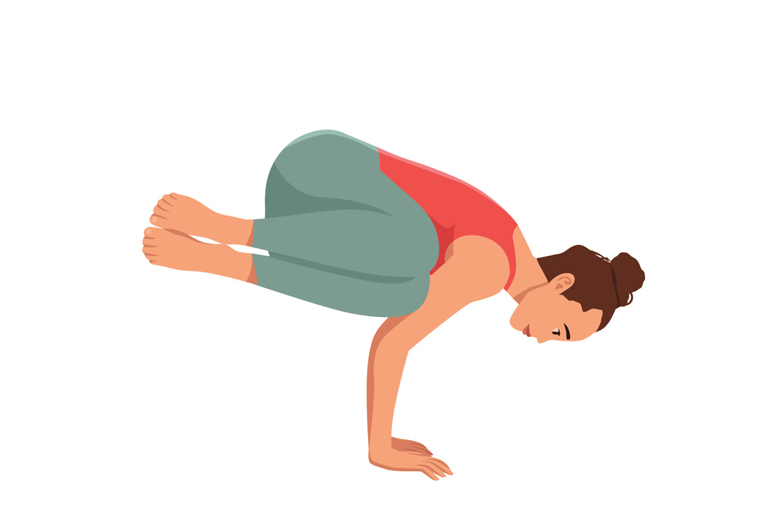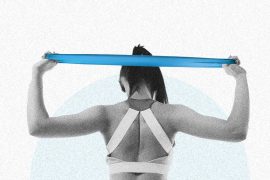Parsva Bakasana, also known as Side Crow Pose, is a challenging arm balance yoga posture that requires strength, balance, and concentration. In this pose, the practitioner balances the body on the hands while twisting to one side, with the knees resting on the upper arms. The arms provide a stable foundation as the core engages to lift the hips and legs off the ground. Side Crow Pose strengthens the arms, wrists, and core muscles, while also improving balance and coordination. Additionally, the twisting motion stimulates the digestive organs, aiding in digestion and detoxification. Regular practice of Parsva Bakasana can cultivate mental focus, build upper body strength, and enhance overall body awareness.
How to practice Parsva Bakasana:
- Begin in a squatting position (Malasana) with your feet hip-width apart or slightly wider. Place your palms flat on the floor shoulder-width apart, fingers spread wide, and fingers facing forward.
- Shift your weight onto your hands and start to lean forward, bringing your knees towards your upper arms, near the armpits.
- Slowly lift one foot off the ground, engaging your core and pressing firmly through your hands.
- Begin to shift your weight onto the hand that corresponds to the lifted foot, and as you do so, start to lean to the opposite side.
- Extend the lifted leg out to the side, straightening it as much as possible, while keeping the other knee bent and resting on the upper arm.
- Use your core strength to stabilize and balance the pose. Keep your gaze focused slightly forward to help with balance.
- Hold the pose for a few breaths, then gently release and come back to a squatting position.
- Repeat the pose on the other side, lifting the opposite foot and leaning to the opposite side.
Parsva Bakasana strengthens the arms, wrists, core muscles, and shoulders, while also improving balance and focus. It’s important to warm up properly before attempting this pose and to practice under the guidance of a qualified yoga instructor if you’re new to arm balances or have any existing injuries.
Benifits of Parsva Bakasana:
- Strengthens the Upper Body: Practicing Side Crow Pose requires significant strength in the arms, shoulders, wrists, and core muscles. Regular practice helps to build strength in these areas, leading to improved overall upper body strength.
- Improves Balance and Coordination: Balancing on the hands in Parsva Bakasana requires concentration and coordination. Regular practice helps to improve proprioception, balance, and coordination skills.
- Enhances Core Stability: The core muscles are engaged throughout Parsva Bakasana to support the body and maintain balance. This helps to strengthen the abdominal muscles and improve core stability.
- Stretches the Groin and Hips: As the body is positioned in a squatting position and the legs are extended to the side, Side Crow Pose provides a deep stretch to the groin and hips, helping to increase flexibility in these areas.
- Stimulates Digestion: The compression of the abdomen in Parsva Bakasana can help to stimulate digestion and improve gastrointestinal health.
- Develops Focus and Concentration: Balancing poses like Parsva Bakasana require focused attention and concentration. Regular practice can help to cultivate mental focus, clarity, and mindfulness.
- Builds Confidence: Mastering challenging yoga poses like Parsva Bakasana can boost self-confidence and self-esteem. Overcoming obstacles and achieving progress in the practice can foster a sense of accomplishment and empowerment.
- Relieves Stress and Anxiety: Practicing yoga poses, including Parsva Bakasana, promotes relaxation and stress relief by calming the mind and releasing tension from the body.
Overall, Parsva Bakasana is a dynamic yoga pose that offers a wide range of physical and mental benefits, making it a valuable addition to any yoga practice. As with any yoga pose, it’s essential to practice safely and mindfully, listening to your body and respecting its limitations.
Contraindications:
- Avoid Parsva Bakasana if you have any wrist, shoulder, or arm injuries.
- Individuals with carpal tunnel syndrome or other wrist issues should practice with caution or avoid the pose altogether.
- Pregnant individuals or those with high blood pressure should avoid intense arm balances like Parsva Bakasana.
Modifications:
- Use yoga blocks under your hands to elevate the floor, reducing the intensity of the pose.
- Practice with a folded blanket or yoga mat under your head for added comfort and support.
- Begin by practicing the preparatory poses like Crow Pose (Bakasana) or supported variations to build strength and confidence before attempting Parsva Bakasana.
As with any yoga pose, it’s essential to practice mindfully, listen to your body, and respect your limits. If you’re new to Parsva Bakasana or have any concerns, consider practicing under the guidance of a qualified yoga instructor.
Disclaimer:
The information contained in this article is for educational and informational purposes only and is not intended as a health advice. We would ask you to consult a qualified professional or medical expert to gain additional knowledge before you choose to consume any product or perform any exercise.







